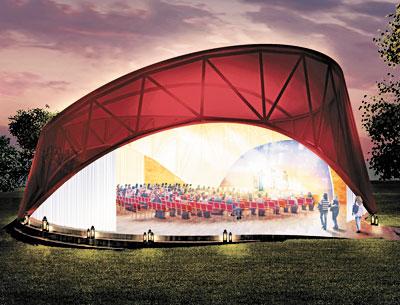New Future for Old Parrish

Many people have been wondering what is going to happen to the space vacated by the Parrish Art Museum. A better question may be, what isn’t?
Southampton Village is embarking on a mission laid out in 2009 to enhance vitality in its core business district; the Southampton Center for the Arts, which will occupy the museum’s former building, is the nerve center of the ambitious plan. Siamak Samii, chairman of the Southampton Village Planning Commission, also serves on the Founders Committee, a 12-member advisory group formed by the village mayor, Mark Epley, to establish new programming, renovate, and restore the 1897 building at 25 Job’s Lane. Mr. Samii said the estimated $12 million endeavor is more than three years from completion.
In the meantime, construction is under way for a state-of-the-art outdoor pavilion designed by the Rockwell Group, whose projects include Mohegan Sun, a Connecticut entertainment and gaming facility; the Elinor Bunin Munroe Film Center at Lincoln Center, and the JetBlue terminal at Kennedy Airport. Rockwell says the “soaring, circular, bright red structure” will be composed of sustainable materials such as steel truss and P.V.C.-coated fiberglass. Fabric will “undulate around the space, acting as a theatrical curtain between surrounding conditions.”
The 300-seat pavilion is slated to offer a full lineup of theater, film, music, and lectures by next summer. In winter, it will house an ice-skating rink. Mr. Samii said the pavilion will function as a “gateway” to the arts center, inviting the community to utilize the three-acre grounds throughout the year.
Mayor Epley envisions the arts center as a place where everyone, from children to the most culturally sophisticated, will go to “experience something new.” The first event held at the vacant site this past summer featured the journalists Bob Woodward and Chris Cuomo, sharing stories of covering the wars in Iraq and Afghanistan.
Mr. Epley said his team, including Mara Manus, interim director of the arts center, will collaborate with such groups as the Baryshnikov Arts Center, Jazz at Lincoln Center, The New-York Historical Society, N.Y.U. Steinhardt Music department, and The Orchestra of St. Luke’s, as well as East End organizations including Bay Street Theatre, the Hamptons International Film Festival, the Southampton Cultural Center, Stony Brook Southampton, Southampton Historical Museum, and the African American Museum of the East End. The mayor said the center will continue to host local artists and that he looked forward to forging partnerships with Guild Hall and Watermill Center to exhibit works from their permanent collections there.
The 19,000-square-foot building’s existing 190-seat auditorium will be brought up to date and expanded, and “remaining spaces will retain flexibility to adapt a particular performance or event,” said Mr. Samii. “A key component of the restoration will be shifting interior walls.” He expects events of every size to be offered, from large symphony and ballet companies to workshops for youths and seniors.
“When it is done,” he said, “It will be a place where people can gather to start, as well as end, the day.” Plans include a cafe offering sandwiches, pastries, and coffee.
The restoration will be in keeping with the style of the Italian Renaissance Revival building. The architect, chosen from a pool of 30, is the Boston-based firm of Machado and Silvetti, renowned for putting a modern spin on historic buildings, including the Boston Public Library, the Provincetown Art Association and Museum, and the Rockefeller family’s Stone Barns Center at Pocantico Hills, N.Y. The firm plans to begin design work this week.
Grosvenor Atterbury was the original architect of the Job’s Lane museum, which opened in 1897 and until now has never been restored. Samuel Longstreth Parrish, the building’s original owner, who housed his art collection there, bequeathed the property to the village in 1932.
Renewal will address bricks that pave the courtyard, ironwork on the fence and main doors, slate and copper roofing, and interior furnishings such as skylights, colonnades, and woodwork. Visitors will enter from multiple entryways, depending on the event; the original “East” entrance will be repurposed.
A private nonprofit entity will maintain the grounds, modeled on the Central Park Conservancy, and create programming, said Mr. Samii.
According to Mayor Epley, the biggest challenge facing the arts center is money. “We’re in difficult financial times,” he said, noting that the village expects to foot under two percent of the projected cost, or $210,000. Private funds and programming revenues, it is hoped, will pay for the rest. “It is very important that people feel like this is their place,” said the mayor.
The basis of a successful community is a strong business district, he added, citing the migration of the library, post office, and now the Parrish away from the village core. If he had his druthers, said Mr. Epley, the nearby privately owned former site of the Rogers Memorial Library would become retail space or “something else people could enjoy.” He foresees the arts center, historical society, galleries, shops, movie theater, and other businesses combining to create a bona fide arts district. The mayor also hopes WPPB, a local public radio station, will occupy a space in the new arts center.
The Parrish has welcomed visitors to downtown Southampton for over 100 years, the mayor observed. “Our plan for the arts center and to enhance Southampton’s business district is also a hundred-year decision.”
